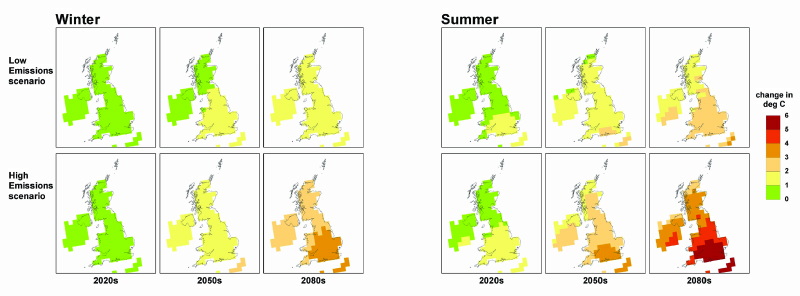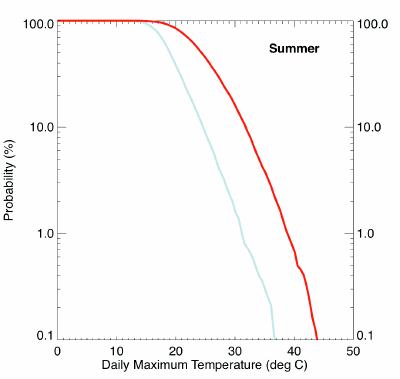The impact of climate change on modern building services

Fig. 1: Some expected climate changes for the UK. (From UKCIP02 Technical report)

Fig. 2: The probability of exceedance for daily maximum temperature in Central England, which is a roughly triangular area of the United Kingdom enclosed by Bristol, Manchester and London, in summer for modelled baseline (1961-90) (grey) and for the medium-high emissions scenario for the 2080s (red). The probability expressed is the probability of the event being exceeded on any given day in the summer season (June/July/August).
Precipitation (rain, hail and snow) and sea level will also change, although these changes are likely to have limited impacts on building services. Precipitation might decrease in summer and increase in winter. It is likely that there will also be more deep depressions in winter, bringing strong winds and intense rainfall. Changes in precipitation are likely to have a greater impact on the building exterior than on building services. However, increases in damp conditions could result in increased problems with mould. Cloud cover is expected to decrease in summer and increase slightly in winter, with the largest summer decreases occurring in the southern UK. Shading of buildings will become more important as a result. Specific humidity will increase in all seasons and regions. However, relative humidity is expected to decrease over the whole UK in summer due to increasing temperatures. Most regions will see a decrease in relative humidity in other seasons also. These changes could affect human comfort and mould growth in the interior of buildings. Changes in wind speed due to climate change are very uncertain, but they are expected to increase in winter and decrease in summer. These changes will be of importance to building design and structure. Conclusion We are already witnessing changes in our climate. Therefore, climate change is a current (not a future issue), and we need to start planning for and adapting to it now. Those involved in planning, design and constructing buildings should take account of the expected climate over the lifetime of the building and its services. Typically, buildings last for 20 to over 100 years, and internal structures and fittings for 15 to 25 or more years, so those who ignore climate change risk creating buildings that will be expensive to run and maintain, and uncomfortable to inhabit. Jacqui Harman is scientific officer with UK Climate Impacts Programme, Union House,12-16 St Michael’s Street, Oxford OX1 2DUenquiries@ukcip.org.uk Footnote 1: HULME, M., JENKINS, G.J., LU, X., TURNPENNY, J.R., MITCHELL, T.D., JONES, R.G., LOWE, J., MURPHY, J.M., HASSELL, D., BOORMAN, P., MCDONALD, R. AND HILL, S. Climate Change Scenarios for the United Kingdom: The UKCIP02 Scientific Report. Tyndall Centre for Climate Change Research, School of Environmental Sciences, University of East Anglia, Norwich, UK. 2002. Table 1: Expected changes in UK climate (based on the UKCIP02 climate change scenarios1) and some impacts on building services. (Quantitative statements are deliberately avoided; see the UKCIP02 Technical Report for detailed data)
| Climate variable | Expected change (UKCIP02 scenarios) | Impacts for building services |
| Temperature | • Annual warming by the 2050s of between 0.5 and 3.5K depending on region and scenario • More very hot days • Fewer very cold days • Greater summer warming in the southeast than in the northwest • Greater night-time than day-time warming in winter • Greater warming in summer and autumn than in winter and spring • Greater day-time than night-time warming insummer | • Could cause increasing in outgassing of pollutants from the structure and furnishing of buildings and surrounding outdoor environment • Potential increase in risk of legionella, especially where ventilation systems are poorly maintained |
| • Heating degree days | • Reduction in heating degree days of -10% to -45% by 2080s | • Buildings requiring less heating |
| • Cooling degree days | • Increase in cooling degree days by 0 to 300 days per year by 2080s, depending on location | • Problems with overheating in summer |
| Precipitation | • Small annual decrease in precipitation | • Variable moisture levels can have an impact on insulation performance |
| • Winter rainfall | • Generally wetter winters for the whole UK • More intense rainfall events | • Increased rain penetration and dampness problems • Could lead to increase mould growth • Increased risk of fluvial flooding |
| • Summer rainfall | • Substantially drier summers for the whole UK | • Decreased summer rainfall could lead to water problems and drying of soils, resulting in subsidence and cracking of buildings |
| • Deep depressions | • Winter depressions become more frequent | • Increased risk of flooding • Increased risk of storm damage |
| Soil moisture | • Decreases in summer and autumn in the southeast • Increases in winter and spring in the northwest | • Changed soil moisture levels will influence seasonal performance of ground source heat pumps • Increased risk of subsidence and cracking in summer |
| Cloud cover/ Solar irradiance | • Reduction in summer and autumn cloud, especially in the south, and an increase in radiation • Small increase in winter cloud cover | • Increased need for shading on windows |
| Humidity | • Specific humidity increases throughout the year • Relative humidity decreases in summer | • Implications for human comfort and design of HVAC systems |
| Wind | • Changes in wind are very uncertain. Wind speeds are expected to be similar to present. • There could be more windy periods in winter as the occurrence of deep depressions increases. | • Increased external surface heat transfer rates and unwanted air infiltration with increased wind speed • Increased risk of structural damage to building with increased wind speed |
| Sea level rise | • Increase approximately between 0 to 86 cm by 2080s, depending on location | • Increased risk of flooding and coastal erosion |







